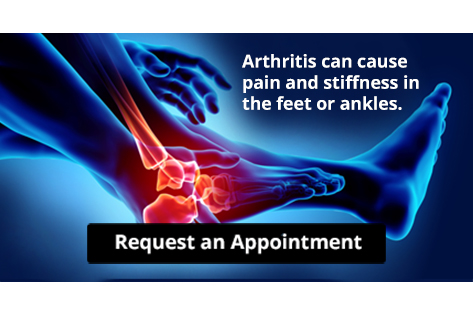A flat foot is a foot that has no visible arch in the middle of the sole of the foot while standing. There are two types of flat feet. A flexible flat foot has a visible arch when the foot is not bearing weight, but the arch disappears when the person stands or puts any weight on the foot. A rigid flat foot has no visible arch regardless of whether or not the foot is bearing any weight. Flat feet can also be present from birth or can develop over time, as the ligaments that hold up the arch of the foot weaken. When flat feet are acquired, they are referred to as fallen arches.
In many cases, flat feet do not cause any pain or other symptoms. This is especially true for those who were born with flat feet. In the instances where flat feet are not asymptomatic, they may cause pain in the heel, arch, ankle, or along the outside of the foot, as well as shin pain, foot aches or fatigue, and lower back, hip, or knee pain. People who have flat feet are also more likely to have an abnormal gait or walking pattern that may affect their daily activities.
Flat feet can be diagnosed through a physical examination. An imaging study, such as an X-ray, may be used to determine the severity of the condition. Treatments for flat feet include footwear and activity modifications, wearing orthotics, taking medications to relieve pain, and physical therapy. If you have flat feet that are causing you pain or discomfort, please consult with a chiropodist.
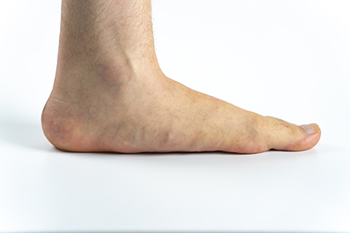
Flat feet are also known as pes planus, or fallen arches. Having flat feet can pose a number of health issues and should be taken seriously. A normal foot has an arch between the toes and heels that can be noticed while standing on the floor. A flat foot has no space between the bottom of the foot and the floor. Fallen arches may be caused by increased elastin during pregnancy, arthritis, or from putting excessive stress on the foot. A rigid flat foot appears flat even when it is at rest. This type of flat foot can cause pain in the foot, as well as in the legs, knees, and back. Many people with flat feet are able to live pain-free lives with the help of orthotics and certain exercises. If you have noticed that your feet hurt and are not sure of the cause, you may have developed fallen arches. It is suggested that you consult a chiropodist who can examine your foot’s arch structure and offer appropriate treatment solutions.
Flat feet are a common foot condition. If you are experiencing pain or discomfort due to flat feet, please consult with one of the specialists from Thornhill Foot Clinic. Our chiropodists will assess your condition and provide you with quality foot and ankle treatment.
What Are Flat Feet?
Flat feet are feet that do not have a well-defined arch in the middle of the sole of the foot. Flat feet may be flexible or rigid. Flexible flat feet have an arch when there is no pressure put on the foot, such as when one is sitting, but the arch disappears upon standing. Rigid flat feet lack an arch regardless of whether one is standing or not.
Causes
Flat feet can be present from birth or acquired over time due to a weakening of the ligaments in the arch. Sometimes flat feet are caused by illnesses, injuries, or pregnancy.
Symptoms
Flat feet often cause no noticeable symptoms. However, some people may experience pain and discomfort due to their flat feet.
Symptoms associated with flat feet include:
Pain in the arch, heel, ankle, or along the outside of the foot
Overpronation of the foot
Shin splints
Aching or fatigue in the feet or legs
Pain in the knees, hips, or lower back
Treatment
In cases where flat feet cause symptoms, there are various treatments available. Wearing orthotic inserts in your shoes to provide more arch support, performing stretches, and taking medications may improve your symptoms. If you are overweight, losing weight can help relieve pressure on the feet. In severe cases, surgery may be considered.
If you have any questions, please feel free to contact our office located in . We offer the newest diagnostic and treatment technologies for all your foot care needs.
Gout is a type of arthritis that can affect the foot. Gout is caused by a buildup of uric acid in the bloodstream. When uric acid levels become excessive, this substance can create crystals in the joints, causing severe pain, intense swelling, redness, and warmth. Typically this occurs in the big toe joint.
You may be at an increased risk of developing gout if you are a middle-aged man or postmenopausal woman, have family members who have had gout, drink alcohol, take certain medications, or have a medical condition like high blood pressure, kidney disease, thyroid disease, diabetes, or sleep apnea. Gout may also be more likely to develop if you consume a diet high in sugars or purines, a substance that turns into uric acid when it breaks down. Foods high in purines include organ meats, red meat, oily fish, certain vegetables, beans, and mushrooms.
Gout that is left untreated can become chronic and lead to arthritis. Gout can be treated by a chiropodist. Treatment options may include taking medications to relieve pain and prevent future gout attacks, modifying your diet, and reducing alcohol intake. For more information about gout, please consult with a chiropodist.
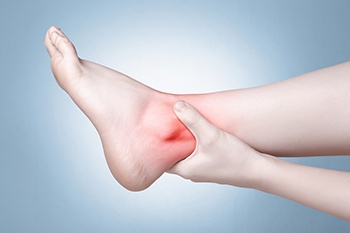
Most people associate gout with pain that centers in the big toe, and this is certainly a common location for a flare up. However, there are many joints where gout can occur, including the ankle. Because ankle sprains, tendonitis, and osteoarthritis share similar symptoms with gout, it can easily be misdiagnosed. Gout is an inflammatory condition, a type of arthritis, resulting from a buildup of uric acid that forms into crystals in the joints. Symptoms of gout, though similar to those of other conditions, are usually far more acute and happen for no discernable reason. A typical flare up causes immediate extreme pain and produces swelling, redness, and tenderness to the touch. The bouts often occur in the middle of the night and completely without warning. The swelling can, in turn, cause stiffness in the ankle that may last for a week or longer, though it may start out as a dull ache. A decreased range of motion in the ankle is another sign of gout. This can affect a patient’s ability to move the ankle, bear weight, or walk. There is no known cure for gout, but there are a number of treatment solutions that reduce pain and prevent future flare ups. For more information on gout, it is suggested that you consult a chiropodist.
Gout is a painful form of arthritis that can affect anyone. Please consult with one of the specialists from Thornhill Foot Clinic. Our chiropodists will assess your condition and provide you with quality foot and ankle treatment.
What Is Gout?
Gout is characterized by sudden, severe attacks of pain, redness, and tenderness in the joints. This type of arthritis is caused by a buildup of uric acid in the bloodstream. When uric acid crystallizes in a joint, often the joint of the big toe, it can bring about a gout attack.
Symptoms
Symptoms of gout include:
Sudden and severe pain
Swelling
Redness
Warmth
Joint stiffness
Joint deformity
Diagnosis
A chiropodist will ask questions about your personal and family medical history, followed by an examination of the affected joint. Laboratory tests and x-rays are sometimes ordered to determine if the inflammation is caused by something other than gout. A sample of fluid taken from your joint can show whether it contains uric acid.
Treatment
Prescription medications or injections are used to treat the pain, swelling, and inflammation. Patients with chronic gout can also use behavioral modifications such as diet, exercise, and decreased intake of alcohol to help minimize the frequency of gout attacks. Foods and beverages that are high in purines should be avoided since purines are converted in the body to uric acid. If left untreated, this painful condition can leave your joint permanently damaged and swollen.
If you have any questions, please feel free to contact our office located in . We offer the newest diagnostic and treatment technologies for all your foot care needs.
Good foot care is proactive, rather than reactive. While a chiropodist can diagnose, treat, and help you manage a variety of foot and ankle conditions, preventing foot problems and keeping the feet healthy is something that you can do at home as well. Having and following an established daily foot care routine can be very beneficial.
Maintaining good foot hygiene helps prevent a variety of foot problems, including infections like athlete’s foot and fungal toenails. It is important to wash your feet every day using lukewarm water and mild soap. Wash the entire foot, from heel to toe. Then dry the foot thoroughly, taking extra care to dry in between the toes. Moisturizing the heels and soles of the feet after washing them can help keep the skin soft, hydrated, and free of cracks.
Stretching and strengthening the feet can maintain or improve their mobility. There are many easy foot exercises that you can do to keep your feet strong and flexible, such as toe scrunches and heel raises. Maintaining a healthy diet and exercising regularly can help keep your weight under control, relieving excess pressure and strain on the feet.
Finally, wearing the right shoes is one of the easiest ways to care for the feet. Many people wear shoes that are too tight or narrow, shoes that don’t support the feet adequately, and shoes that are made of materials that trap moisture on the foot. Opt for comfortable, properly-fitted shoes that support and protect your feet.
For more information about daily foot care practices for good foot health, please consult with a chiropodist.
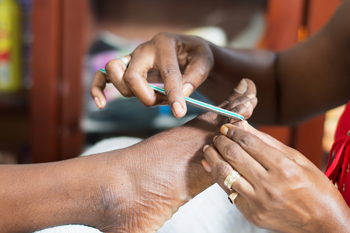
Research has shown the average person takes thousands of steps per day. Many people have achy feet at the end of the day, and everyday foot care ideas can be implemented. The feet are the foundation of the body. Implementing foot care routines can help the feet to look and feel better. It takes minimal time and generally begins with washing and drying the feet, followed by using a scrub that can help to exfoliate dead skin. A moisturizer can help the feet to feel soft, and may also prevent cracked heels. Using foot powder is beneficial in absorbing any sweat that can collect between the toes, and many people enjoy using a foot mask that can revitalize the feet. If you would like more information about effective everyday foot care tips, it is suggested that you schedule an appointment with a chiropodist
Caring for your feet is not just something done at the chiropodist’s office. Good foot care starts at home. If you would like to learn more about daily foot care practices, please consult with one of the specialists from Thornhill Foot Clinic. Our chiropodists can help you maintain the health of your lower limbs and your mobility.
There are many things that you can do at home to help care for your feet, including:
Wearing shoes and socks that fit properly
Washing the feet daily with soap and water
Drying the feet thoroughly
Applying moisturizer to the soles and heels of the feet
Taking a walk and exercising the feet regularly
Doing foot stretches and strengthening exercises
A chiropodist can help figure out a manageable foot care routine for you to keep your feet healthy. If you have any questions, please feel free to contact our office located in . We offer the newest diagnostic and treatment technologies for all your foot care needs.
The Achilles tendon, located at the back of the lower leg, is a strong band of fibrous tissue that connects the calf muscles to the heel bone. There are several different types of Achilles tendon injuries. The two most common injuries are Achilles tendonitis and Achilles tendon ruptures.
When the tendon is injured due to repetitive strain and overuse, it can result in a condition called Achilles tendonitis. This injury is characterized by inflammation of the Achilles tendon, heel and calf pain, thickening of the tendon, ankle and calf stiffness, and a decreased range of motion. In the initial stages of Achilles tendonitis, pain primarily occurs following physical activity, but it can become constant and chronic if the injury is left untreated.
When the Achilles tendon fully tears, it is known as an Achilles tendon rupture. This usually occurs following a sudden, high-impact injury. Symptoms include a sudden, stabbing pain in the back of the affected leg, a popping or snapping sensation, swelling, and difficulty walking and raising the foot. This condition requires prompt treatment to prevent further damage to the tendon.
There are a variety of treatments available for Achilles tendon injuries. Achilles tendonitis can often be treated through conservative methods, such as resting, icing, compressing, and elevating the affected foot, wearing orthotics, taking over-the-counter pain medications, and doing gentle stretches. Achilles tendon ruptures may require surgical treatment to avoid reinjury. For more information about Achilles tendon injuries, please consult with a chiropodist.
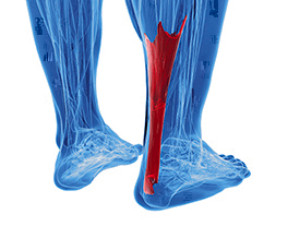
One of the most common causes of heel pain is Achilles tendonitis. This condition is thought to be an overuse injury that affects the Achilles tendon, which connects the muscles of the calf with the heel. The Achilles tendon is made up of thousands of collagen fibers that are tightly packed, to make up the longest and strongest tendon in the body. In most cases, injury to the Achilles tendon occurs gradually, often from not resting long enough between bouts of exercise. Achilles tendonitis can also be the result of what is called overload, which can occur if you increase the length or intensity of a run. Such an injury can also be caused by suddenly switching from shoes with a heel to flats for walking or running. Treatment options include rest, strength and stretching exercises, and certain medications. An injured Achilles tendon can take a long time to heal, but rushing back into activity can cause a chronic condition to develop. A chiropodist can examine your Achilles tendon to determine both the cause and severity of the injury, along with a suggested treatment program.
Achilles tendonitis is a common injury of the Achilles tendon, a band of fibrous tissue that runs along the back of the lower leg. The Achilles tendon can also rupture, making it impossible to lift the foot. If you are suffering from heel or calf pain, please consult with one of the specialists from Thornhill Foot Clinic. Our chiropodists can help you maintain the health of your lower limbs and your mobility.
Causes of Achilles tendon injuries include:
Repetitive stress or overuse
Sudden increase in activity levels
High impact injury
Calf muscle tightness or weakness
Altered foot biomechanics
Heel bone spurs
Underlying medical conditions that weaken the tendon
Symptoms of an Achilles tendon injury include:
Heel and calf pain that worsens following exercise
Chronic heel and calf pain
Sudden pain in the back of the ankle or calf
A popping or snapping sensation
Thickened lump in the Achilles tendon
Ankle and calf stiffness
Decreased range of motion in the affected foot
Swelling
Difficulty walking
Treatment
Resting the affected leg
Applying ice
Compressing the foot and ankle
Elevating the injured leg
Wearing orthotics
Low impact exercises
Stretches
Strengthening exercises
Non-steroidal anti-inflammatory medications
Cortisone injections
Surgery, if the tendon is ruptured
Achilles tendon injuries can be very painful and lead to reduced mobility if left untreated. If you have any questions, please feel free to contact our office located in . We offer the newest diagnostic and treatment technologies for all your foot care needs.
When getting ready for a trip to the pool, the beach, or the boardwalk during the summer months, you may slip on a pair of flip-flops. While wearing these shoes for short periods of time is typically not a problem, wearing flip-flops all day, every day, all summer long is not great for your feet. Frequent flip-flop wear is associated with a host of foot and ankle problems.
Flip-flops are usually flimsy, providing no arch support to the feet. This can make foot pain more likely, particularly in the arches and heels. Your ankles, legs, hips, and even back can also be affected. Flip-flops also provide no protection from the elements or from injury. Cracked heels, direct impacts to the feet, and viral, fungal, and bacterial infections may be more likely to occur if you wear flip-flops often.
Perhaps one of the biggest problems with flip-flops is how difficult they are to keep on your feet. As you walk with flip-flops on, several changes are taking place. Your gait, or walking pattern, shifts to shorter strides, and your toes grip the edges of the flip-flops to keep them on your feet. Over time, these changes can cause toe and foot deformities, such as hammertoes and bunions. You’re also more likely to slip and fall as your shoes flop on your feet and catch on things on the ground below.
To learn more about the dangers of flip-flops, and for help finding alternative summer shoe options, please consult with a chiropodist.
